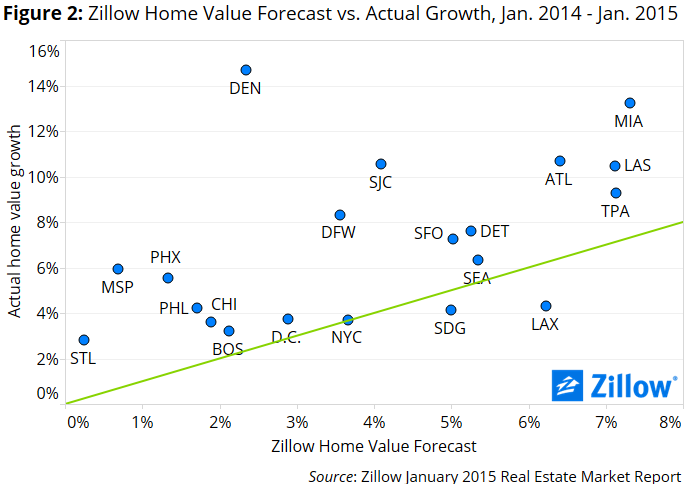- In general, Americans tended to underestimate home value growth in 2014. To a lesser extent, so did expert forecasters.
- Much of consumers’ expectations for future growth seem to be rooted in how their local market performed in the recent past.
- On average, a panel of more than 100 experts said they expected home values to grow 4.5 percent in 2014. The Zillow Home Value Forecast, released in December 2013, called for 4.8 percent growth. Actual home values rose 6.6 percent last year.
Last January, the Zillow Housing Confidence Index asked 10,000 American homeowners and renters in 20 metro areas to predict how local home values would perform over the next year. So, how’d they do?
In general, survey respondents tended to underestimate how much home values would grow in 2014 – particularly in metros that ended up growing very quickly (figure 1, left side). Average expected home value growth was lower than actual home value growth in all 20 metros.[1] Denver and Miami residents were farthest off, while respondents in Boston and San Diego did pretty well.
Respondents’ expectations appear to be more strongly rooted in history. When we compare expected home value growth from our January 2014 survey with our full history of home value growth in each community, the relationship is much stronger and somewhat less downwardly biased (figure 1, right side).[2]
Past Performance, Future Results?
Economists like to warn consumers that when it comes to forecasts, past performance is not necessarily an indicator of future results. But the results of Zillow’s Housing Confidence Survey show that consumers are not always heeding these warnings when forming their own expectations about the future.
While past trends can be a good guide to future movements – particularly for assets like housing, where prices tend to be “sticky” – expectations based on past experience often fail to catch big swings in markets. When markets are rising quickly (as they have during the recent housing recovery), consumers tend to underestimate the increase. When markets are falling quickly (as they did during the housing crash), consumers tend to underestimate the fall.
And it may be easy to criticize consumers’ forecasts, but professionals aren’t much better. The 110 experts surveyed in the January 2014 Zillow Home Price Expectations Survey said they expected the U.S. Zillow Home Value Index to increase 4.5 percent in 2014, on average. Among only the most optimistic quartile of survey respondents, the average expectation was 5.6 percent.[3] Our own Zillow Home Value Forecast called for a 4.8 percent rate of appreciation.
In the end, the U.S. Zillow Home Value Index rose 6.6 percent for the year ending December 2014. Similar to the non-experts, the experts – even the most optimistic experts – underestimated home value growth in 2014.
 On the metro level, our own Zillow Home Value Forecasts from a year ago performed modestly better than respondents in the Zillow Housing Confidence Index (figure 2). Average errors – the difference between the forecast and what actually happened – were slightly smaller and slightly closer together for Zillow’s forecasts compared to the errors associated with survey respondents’ forecasts. On average across the 20 metros in the survey, Zillow’s forecasts were 3 percentage points off. Zillow Housing Confidence Index respondents were, on average, 4 percentage points off.
On the metro level, our own Zillow Home Value Forecasts from a year ago performed modestly better than respondents in the Zillow Housing Confidence Index (figure 2). Average errors – the difference between the forecast and what actually happened – were slightly smaller and slightly closer together for Zillow’s forecasts compared to the errors associated with survey respondents’ forecasts. On average across the 20 metros in the survey, Zillow’s forecasts were 3 percentage points off. Zillow Housing Confidence Index respondents were, on average, 4 percentage points off.
When regressing actual home value growth on the two sets of forecasts, the Zillow forecasts have some modest predictive power, while the consumer expectations have essentially no significant predictive value.[4]
So if the forecasts were off in this case, is there value at all in polling consumers (and, to a lesser extent, experts) about their expectations for future home value growth? While such statistical nihilism can be appealing when faced with large forecast errors, forming, evaluating and refining our expectations about the future is necessary for any number of forward-looking decisions that shape peoples’ lives. And while it can be intuitively simplistic, anchoring our expectations in the past, as consumers tend to do – particularly the recent past – can be deeply misleading.
[1] Mean error of 4.0 percentage points.
[2] Mean error of 1.3 percentage points.
[3] Grant Thrall, President of the American Real Estate Society, holds the distinction of submitting the best forecast in January 2014. His forecast for ZHVI growth in 2014 was 6.7 percent.
[4] In a simple linear regression, the ZHCI survey expectations are not significant and the regression has an adjusted R-squared of 3.9 percent while the ZHVI forecasts were statistically significant with a 95 percent confidence interval and the regression has an adjusted R-squared of 20.1 percent.